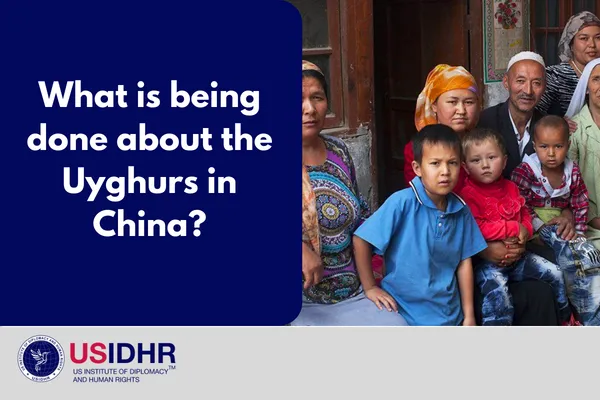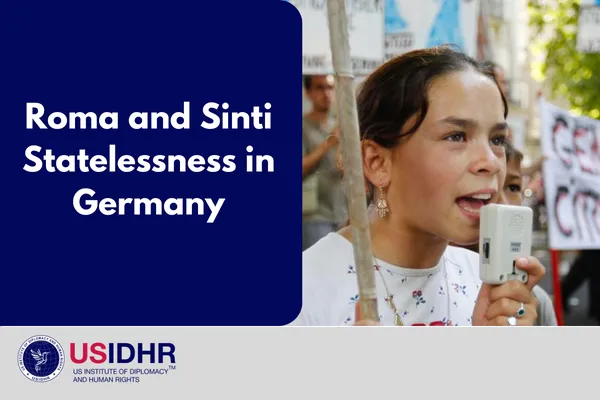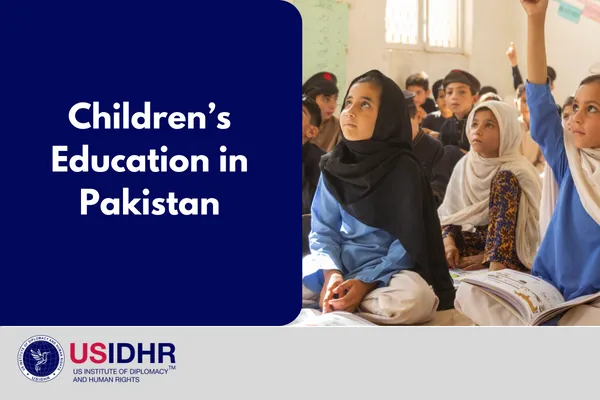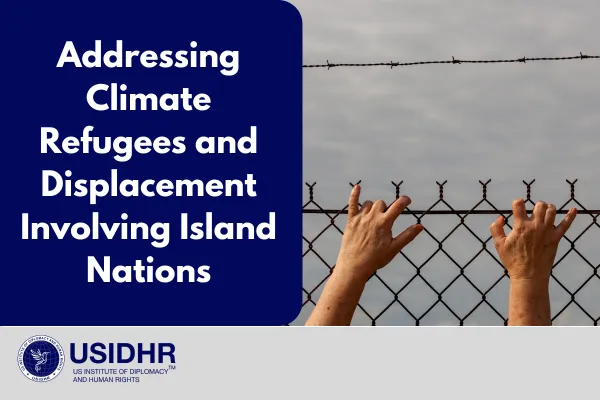
Addressing Climate Refugees and Displacement Involving Island Nations
September 10, 2021 by usidhr.org
7 min read
Introduction
Climate change - and climate displacement - are not merely threats of the future, but are already part of life for the inhabitants of drowning or sinking island nations now (though they are projected to increase tremendously in the future if nothing is done to address them). Drowning or sinking islands, once considered merely part of the destructive potential of climate change, are a threat islands and low-lying states today must grapple with . Islands have already drowned underwater . Tebunginako (translating to ‘’jutting out’’), once a village in the Republic of Kiribati island nation, saw its inhabitants relocate entirely as water inundated the island and overpowered the coastal defenses, to the point the only thing seen when the tide comes in is reportedly ‘’a church sitting in the middle of the sea’’ . East Island in Hawaii, hit by Hurricane Walaka (a storm classified under category 5, the highest classification in the scale) in 2018, disappeared underwater . Perlamutrovy, meaning ‘’the mother of all pearls’’ in Russian, is the name of an Arctic island that has submerged entirely in 2018 . Five islands - part of the Solomon Islands, a Pacific archipelago - have also suffered this fate . Climate change has the potential to deprive people of their homes and render them stateless. It is also a human rights problem - and its manifestations infringe on people’s human rights from a human security perspective. This article looks at some of the rights potentially at risk due to climate change and what can be done to restore them.
Forms of climate change and its impact:
Climate change impacts countries both in the forms of fast-onset events and slow-onset events. A fast-onset event, also termed as a rapid-onset event, can be a distinct event taking place in a matter of days or hours. A slow-onset event occurs due to gradual changes occurring over several years or an increased frequency or intensity of recurring events . Fast-onset events include droughts, storms, and floods, while slow-onset events include increasing temperatures, rising sea levels, acidification of water, soil salinity, and degradation of land. Therefore, sunken islands are not the only form climate change can take . While slow-onset events may not pose as immediate a danger as fast-onset events, the former are more likely to result in short-term displacement and if part of a chain, can diminish household assets enough to encourage long-term migration. In fact, slow-onset events are more likely to drive permanent migration .
Slow-onset changes like sea level rises produce the most impact and make lands uninhabitable in island nations like Kiribati, for example . The worse it gets, climate change has the potential to accentuate the problem. Empirical evidence shows that storms and weather-based events have gotten worse since 2008, displacing an average of 24.1 million people annually and globally . Most recently, the United Nations released a climate change report issuing a ‘’code red for humanity’’, warning that island nations the world over are on the ‘’edge of extinction’’ and human-caused climate change will cause ‘’unprecedented’’ extreme events unless immediate global actions are taken . Similarly, a 2016 United Nations report shows that half of all households have already suffered due to sea level rise on the island of Kiritimati, a coral atoll in the Republic of Kiribati and one of the most climate vulnerable inhabited islands on the planet. In addition, one-in-seven of all relocations in Kiribati occur because of environmental change . People have already moved away from Kiritimati for these reasons and more .
How does climate change impact populations and their human rights?
Climate change has already forced many inhabitants of island nations to leave and may force still more to leave. Yet these people, informally called ‘’climate refugees’’ or ‘’climate migrants’’, have relatively little legal protection. Neither term has any recognition under international law, and nor does ‘’environmental refugee’’ - even though the UN Environment Program (UNEP) researcher Essam El-Hinnawi used it in the 1985 report titled "Environmental Refugees’’ . Under Article 14 of the Universal Declaration on Human Rights, everyone has the right to seek and to enjoy in other countries asylum from persecution - nowhere is the climate mentioned. Likewise, the 1951 Refugee Convention defines the refugee as a person who has a '’well-founded fear of being persecuted for reasons of race, religion, nationality, membership of a particular social group or political opinion'’ - the climate, again, goes unmentioned .
However, what also cannot be denied is that climate change and its effects reduce people’s access to certain rights found in the Universal Declaration of Human Rights (UDHR). For instance, people’s right to life - Article 25, the right to food and shelter. Climate change threatens food supply, and by proxy, the right to food. Sea level rise and flooding brings saltwater onto agricultural lands and makes them uncultivable, threatening island nationals’ access to food. Climate change, through increasing sea surface temperatures, damages coral reefs - natural breeding and feeding grounds for fishes - and thereby reduces fish stock, the other major source of food for members of island nations . Climate change threatens housing and the right to shelter both directly and indirectly - damaging or even outright destroying buildings and settlements, and displacing the land that is the base for many homes in low-lying islands, respectively . Yet another right violated is Article 3 - the right to life - is one of multiple human rights impacted by climate change. Climate change threatens and kills people on island- and low-lying nations in the forms of storms, droughts, floods, and spread of diseases . Another human right that climate change threatens is Article 15, the right all people have to a nationality. As earlier discussed, certain people may stand to lose their very nations.
Additionally, even if climate migrants may not be considered ‘’traditional’’ refugees or asylum-seekers, it would still be wrong to say climate ‘refugees’ go totally unrecognized internationally. While addressing the case of Ioane Teitiota and his family from Kiribati who sought asylum in New Zealand, the UN Human Rights Committee has ruled that climate refugees or migrants can’t be sent home, acknowledging that the effects of climate change “pose a serious threat to the right to life of people living in countries like Kiribati” . The Global Compact for Safe, Orderly, and Regular Migration (GCM), a major global agreement on migration, has explicitly referred to the need to address protection gaps for people displaced by climate change . While the compact has no legal force, it is the forerunner for the International Migration Review Forum, which will review climate change and migration in 2022 .
What can be done?
Voluntary immigration programs have arisen as potential and actual solutions. New Zealand has created an annual opportunity lottery called the Pacific Access Ballot, allowing 75 Kiribati citizens every year to resettle in the former country . In October 2017, New Zealand announced the world’s first ‘’humanitarian visa’’, enabling 100 Pacific Islanders facing climate change and its effects to move to New Zealand . However, due to Pacific Islanders largely preferring to stay and adapt their living conditions, reduce emissions, and only ‘’migrate with dignity’’ as a relative last resort, applicants for the Pacific Access Ballot have been few in number and the government eventually abandoned the proposed humanitarian visa . Many inhabitants of island- or low-lying nations, simply put, do not want to leave their homes - not even at such great risk - and prefer to adapt instead if possible. In 2008, Pacific Island leaders signed the Niue Declaration, recognizing peoples’ wish to live in their home countries and encouraged signatory nations to adapt to the impacts of climate change . Even then, appetite for humanitarian visas still exists - US Senator Ed Markey recently introduced a bill recognizing “climate-displaced persons” that would resettle 50,000 people in the US each year, and President Joe Biden has ordered a determination on identifying and resettling people displaced directly or indirectly by climate change .
Voluntary relocation within the island is another strategy . Outside of small atoll islands, Pacific scholars agree that most displacement in vulnerable islands will likely be within borders . Vanuatu, an island state, created a comprehensive policy on climate change and disaster-induced displacement, entailing developing safeguards and standard operating procedures for planned relocation . In 2014, residents of Vunidogoloa, Fiji, relocated inland, where hundreds of thousands of dollars went into constructing new houses, fish ponds, and farms - more villages are earmarked for potential relocation. Relocation has also happened in the Solomon Islands, where there are plans to relocate the capital, Taro (less than 2m above sea level), to higher ground . Papua New Guinea has also been relocating its people from the Cartaret Islands (1.2m above sea level), albeit at a slow rate . In the low-lying country of Bangladesh, a report by the Dhaka-based International Centre for Climate Change and Development (ICCD) identifies and proposes transforming inland towns far away from vulnerable coastal areas into “climate-resilient, migrant-friendly” towns that can house millions of internal migrants displaced by coastal flooding, erosion, and other effects of climate change, as well as ideas such as providing scholarships to encourage students to move inland for studies .
Other solutions have included elevating the islands above the rising seas . Some islands are naturally growing in elevation, so even moving people from more anger-prone islands to growing islands may be viable - and in the case of Perlamutrovy, a dozen new islands appeared even as an old one disappeared underwater . It is possible to artificially raise the height of islands like Kiribati by dredging nearby lagoons or rebuilding old roads built on coral reefs as elevated bridges. The Republic of Maldives has created an island to house 50,000 people.
Though dredging sediment damages coral reef ecosystems, the Kiribati government sees the process as necessary as some key infrastructure can’t be easily relocated. Japan - following the 2011 Tohoku Earthquake and Tsunami, which sunk and ruined massive amounts of coastal land - reversed said land loss along 200 km of the coastline in a few years, through returning coastal areas to their original heights or even increasing them to counteract sea level rises far faster than the one projected to occur this very century . The people of Tubigon, Bohol, in Philippines adapted to regular flooding through piling up coral stones to expand their islands, rebuilding their houses’ foundations and placing them on stilts, or using all bamboo furniture called ‘’lantay’’ to elevate themselves and important items during home flooding .
Even simpler strategies, like planting salt-resistant and heat-resistant crops, transitioning from fish to lower cost aquaculture like clams, or sowing food crops along coastlines to reduce flooding, erosion, and reliance on coastal fisheries, can ease the effects of climate change . Education has greatly supported island communities in implementing these endeavors, with women’s groups and local conservation NGOs - among others - leading.
Ultimately, such forward-thinking strategies can go a long way in preserving the right to food, shelter, and nationality, and thereby reduce or prevent climate change-induced displacement . However, while some island communities may be able to adapt, some will face the limits of adaptation and hence need to rely on external migration in order to survive .
Conclusion
Climate change is not an issue of the future, but one of the present - and it is not just an issue of science, but one of human rights. People living in island countries and communities are at risk of losing multiple valuable human rights - if nothing is done to help them
Reference list:
[1] Ahmed, Istiakh, Riadadh Hossain, Tasfia Tasnim, Shahrin Mannan, and Dr. Saleemul Huq.‘’Research Report on Understanding Climate Change Vulnerability in Two Coastal Villages in Bangladesh and Exploring Options for Resilience.’’ International Centre for Climate Change and Development (ICCCAD). April 2019. http://www.icccad.net/wp-content/uploads/2019/04/Panii_Jibon_ICCCAD_Action_Research_Report_2019.pdf
[2] Anderson, Charles. “New Zealand Considers Creating Climate Change Refugee Visas.” The Guardian. October 31, 2017. Accessed August 23, 2021. https://www.theguardian.com/world/2017/oct/31/new-zealand-considers-creating-climate-change-refugee-visas.
[3] Angenendt, Steffen, and Anne Koch. “How Germany Can Benefit from the Global Compact for Migration.” Stiftung Wissenschaft Und Politik (SWP). September 27, 2019. Accessed August 23, 2021. https://www.swp-berlin.org/en/publication/how-germany-can-benefit-from-the-global-compact-for-migration.
[4] Alam, Sarder Shafiqul, Saleemul Huq, Faisal Bin Islam, and Hasan Mohammed Asiful Hoque. “Building Climate-Resilient, Migrant-Friendly Cities and Towns.” International Centre for Climate Change and Development (ICCCAD). July 2018. Accessed August 24, 2021. http://www.icccad.net/wp-content/uploads/2018/10/Policy-Brief-on-Climate-Migration-and-Cities.pdf.
[5] Alexis-Martin, Becky, James Dyke, Jonathan Turnbull, and Stephanie Malin. “How to save a Sinking Island Nation.” BBC Future. August 15, 2019. Accessed August 23, 2021. https://www.bbc.com/future/article/20190813-how-to-save-a-sinking-island-nation.
[6] Barnett, Jon, and Celia Mcmichael. “The Effects of Climate Change on the Geography and Timing of Human Mobility.” Population and Environment 39, no. 4 (2018): 339-56. doi:10.1007/s11111-018-0295-5.
[7] “Become a Human Rights Consultant Certificate Program.” Accessed August 04, 2021. https://usa.usidhr.org/humanrights.
[8] Berchin, Issa Ibrahim, Isabela Blasi Valduga, Jéssica Garcia, and José Baltazar Salgueirinho Osório De Andrade Guerra. “Climate Change and Forced Migrations: An Effort towards Recognizing Climate Refugees.” Geoforum 84 (2017): 147-50. doi:10.1016/j.geoforum.2017.06.022.
[9] Chow, Denise. “Three Islands Disappeared in the past Year. Is Climate Change to Blame?” NBCNews.com. June 9, 2019. Accessed August 23, 2021. http://www.nbcnews.com/mach/science/three-islands-disappeared-past-year-climate-change-blame-ncna1015316.
[10] “Climate Change 2021: The Physical Science Basis.” IPCC. Accessed August 23, 2021. https://www.ipcc.ch/report/sixth-assessment-report-working-group-i/.
[11] “Coastal Erosion.” U.S. Climate Resilience Toolkit. Accessed August 24, 2021. https://toolkit.climate.gov/topics/coastal-flood-risk/coastal-erosion.
[12] “Consultant – Development of Relocation Guidelines for Solomon Islands.” Consultant – Development of Relocation Guidelines for Solomon Islands. Accessed August 23, 2021. https://australia.iom.int/vacancy/consultant-–-development-relocation-guidelines-solomon-islands.
[13] ’Convention relating to the Status of Refugees’’. United Nations. 28 July 1951. https://www.un.org/en/genocideprevention/documents/atrocity-crimes/Doc.23_convention%20refugees.pdf.
[14] Dannenberg, Andrew L., Howard Frumkin, Jeremy J. Hess, and Kristie L. Ebi. “Managed Retreat as a Strategy for Climate Change Adaptation in Small Communities: Public Health Implications.” Climatic Change 153, no. 1-2 (2019): 1-14. doi:10.1007/s10584-019-02382-0.
[15] El-Hinnawi, Essam. “Environmental Refuge es.” United Nations. 1985. Accessed August 31, 2021. https://digitallibrary.un.org/record/121267?ln=en.
[16] García, Stephanie. “What a UN Ruling Could Mean for Climate Refugees.” PBS. December 13, 2019. Accessed August 23, 2021. https://www.pbs.org/newshour/science/as-cop-25-ends-a-look-at-why-climate-migrants-dont-have-refugee-status.
[17] Gertcyk, Olga. “Changing Face of the Arctic: One Significant Island Vanishes from the Map but a Dozen Appear.” March 28, 2019. Accessed August 23, 2021. https://siberiantimes.com/other/others/news/changing-face-of-the-arctic-one-significant-island-vanishes-from-the-map-but-a-dozen-appear/.
[18] “Global Internal Displacement Database.” Internal Displacement Monitoring Center (IDMC). 2020. Accessed August 23, 2021. https://www.internal-displacement.org/database/displacement-data.
[19] Esteban, Miguel, Ma. Laurice Jamero, Leonard Nurse, Lilian Yamamoto, Hiroshi Takagi, Nguyen Danh Thao, Takahito Mikami, Paul Kench, Motoharu Onuki, Angelie Nellas, Richard Crichton, Ven Paolo Valenzuela, Christopher Chadwick, John Erick Avelino, Nicholson Tan, and Tomoya Shibayama. “Adaptation to Sea Level Rise on Low Coral Islands: Lessons from Recent Events.” Ocean & Coastal Management 168 (2019): 35-40. doi:10.1016/j.ocecoaman.2018.10.031.
[20] Farbotko, Carol. “No Retreat: Climate Change and Voluntary Immobility in the Pacific Islands.” June 13, 2018. Accessed August 23, 2021. https://www.migrationpolicy.org/article/no-retreat-climate-change-and-voluntary-immobility-pacific-islands.
[21] Hall, Nina. “New Zealand: A Global Leader on Climate and Displacement?” Policy Forum. June 25, 2019. Accessed August 23, 2021. https://www.policyforum.net/new-zealand-a-global-leader-on-climate-and-displacement/.
[22] “Information about: Pacific Access Category Resident Visa.” Immigration New Zealand. Accessed August 23, 2021. https://www.immigration.govt.nz/new-zealand-visas/apply-for-a-visa/visa-factsheet/pacific-access-category-resident-visa?fbclid=IwAR3AinhCf9d_3NFSNaWFDZ2RWjY42igIcBTm5OWAGv8D1g3atv4Vjb_R5o8.
[23] Jamero, Ma. Laurice, Miguel Esteban, and Motoharu Onuki. “Potential In-Situ Adaptation Strategies for Climate-Related Sea-Level Rise: Insights from a Small Island in The Philippines Experiencing Earthquake Induced Land Subsidence.” International Journal of Sustainable Future for Human Security 4, no. 2 (2016): 44-53. doi:10.24910/jsustain/4.2/4453.
[24] Kelman, Ilan. “No Change from Climate Change: Vulnerability and Small Island Developing States.” The Geographical Journal 180, no. 2 (2013): 120-29. https://discovery.ucl.ac.uk/id/eprint/1437001/1/KelmanSIDSCCFinalSubmitted.pdf
[25] Mack, Eric. “A Hawaiian Island Has Disappeared Beneath The Pacific Ocean.” Forbes. October 24, 2018. Accessed August 23, 2021. https://www.forbes.com/sites/ericmack/2018/10/23/a-hawaiian-island-is-now-completely-underwater-after-taking-a-hit-from-a-category-5-hurricane/?sh=428223fc2a11.
[26] Malo, Sebastien. “Rising Seas Submerge Five Pacific Islands, Researchers Find.” Reuters. May 9, 2016. Accessed August 24, 2021. https://www.reuters.com/article/climatechange-islands-submerged/rising-seas-submerge-five-pacific-islands-researchers-find-idINKCN0Y107G.
[27] Mcleod, Elizabeth, Mae Bruton-Adams, Johannes Förster, Chiara Franco, Graham Gaines, Berna Gorong, Robyn James, Gabriel Posing-Kulwaum, Magdalene Tara, and Elizabeth Terk. “Lessons From the Pacific Islands – Adapting to Climate Change by Supporting Social and Ecological Resilience.” Frontiers in Marine Science 6 (2019). doi:10.3389/fmars.2019.00289.
[28] Mcnamara, Karen E., and Helene Jacot Des Combes. “Planning for Community Relocations Due to Climate Change in Fiji.” International Journal of Disaster Risk Science 6, no. 3 (September 21, 2015): 315-19. doi:10.1007/s13753-015-0065-2.
[29] Nunn, Patrick, and Roselyn Kumar. “Understanding Climate-human Interactions in Small Island Developing States (SIDS).” International Journal of Climate Change Strategies and Management 10, no. 2 (2017): 245-71. doi:10.1108/ijccsm-01-2017-0012.
[30] “NZ Immigration Launches Annual Pacific Access.” Radio New Zealand (RNZ). March 27, 2018. Accessed August 23, 2021. https://www.radionz.co.nz/international/pacific-news/353493/nz-immigration-launches-annual-pacific-access.
[31] Oakes, Robert, Andrea Milan, and Jillian Campbell J. ‘’Kiribati: Climate change and migration – Relationships between household vulnerability, human mobility and climate change.’’ Report No. 20. Bonn: United Nations University Institute for Environment and Human Security (UNU-EHS). 2016. https://collections.unu.edu/eserv/UNU:5903/Online_No_20_Kiribati_Report_161207.pdf
[32] Office of the United Nations High Commissioner for Human Rights. ‘’Understanding Human Rights and Climate Change – Submission of the Office of the High Commissioner for Human Rights to the 21st Conference of the Parties to the United Nations Framework Convention on Climate Change.’’ 2015. https://www.ohchr.org/Documents/Issues/ClimateChange/COP21.pdf
[33] Pala, Christopher. “Kiribati’s President’s Plans to Raise Islands in Fight against Sea-level Rise.” The Guardian. August 9, 2020. Accessed August 23, 2021. https://www.theguardian.com/world/2020/aug/10/kiribatis-presidents-plans-to-raise-islands-in-fight-against-sea-level-rise.
[34] Parvaz, D. “Fighting Bureaucracy to Rebuild.” Environment | Al Jazeera. March 10, 2012. Accessed August 23, 2021. https://www.aljazeera.com/indepth/features/2012/03/201239122211138361.html.
[35] Perumal, Nikita. ““The Place Where I Live Is Where I Belong”: Community Perspectives on Climate Change and Climate-related Migration in the Pacific Island Nation of Vanuatu.” Island Studies Journal 13, no. 1 (2018): 45-64. doi:10.24043/isj.50.
[36] Peters, Adele. “This Pacific Island Nation Plans to Raise Itself above the Ocean to Survive Sea Level Rise.” Fast Company. August 12, 2020. Accessed August 23, 2021. https://www.fastcompany.com/90539048/this-pacific-island-nation-plans-to-raise-itself-above-the-ocean-to-survive-sea-level-rise.
[37] Risser, Mark D., and Michael F. Wehner. “Attributable Human‐Induced Changes in the Likelihood and Magnitude of the Observed Extreme Precipitation during Hurricane Harvey.” Geophysical Research Letters 44, no. 24 (2017). doi:10.1002/2017gl075888.
[38] Salem, Saber. “Climate Change and Food Security in the Pacific.” E-International Relations. February 18, 2020. Accessed August 24, 2021. https://www.e-ir.info/2020/02/18/climate-change-and-food-security-in-the-pacific/.
[39] Sherbinin, Alex De. “Climate Impacts as Drivers of Migration.” Migration Policy Institute (MPI). October 23, 2020. Accessed August 23, 2021. https://www.migrationpolicy.org/article/climate-impacts-drivers-migration.
[40] Staalesen, Atle. “The Arctic Island That Disappeared.” The Independent Barents Observer. February 22, 2019. Accessed August 23, 2021. https://thebarentsobserver.com/en/arctic/2019/02/arctic-island-disappeared.
[41] “Synopses Series: Slow Onset Events.” United Nations Framework Convention on Climate Change. November 26, 201 2. Accessed August 31, 2021. https://unfccc.int/files/adaptation/application/pdf/soe_synopsis.pdf.
[42] “The Slow Onset Effects of Climate Change and Human Rights …” Human Rights Council (HRC). March 23, 2018. Accessed August 24, 2021. https://www.ohchr.org/EN/HRBodies/HRC/RegularSessions/Session37/Documents/A_HRC_37_CRP.4.docx.
[43] Thomas, Alice, and Mark Yarnell. “Ensuring That the Global Compacts on Refugees and Migration Deliver.” Refugees International. September 25, 2019. Accessed August 23, 2021. https://www.refugeesinternational.org/reports/2018/11/19/ensuring-that-the-global-compacts-on-refugees-and-migration-deliver.
[44] United Nations. ‘’REPORT ON NEW ZEALAND’S VIEWS ON THE POSSIBLE SECURITY IMPLICATIONS OF CLIMATE CHANGE’’. https://www.un.org/esa/dsd/resources/res_pdfs/ga-64/cc-inputs/New_Zealand_CCIS.pdf
[45] “Universal Declaration of Human Rights.” United Nations. Accessed August 23, 2021. https://www.un.org/en/about-us/universal-declaration-of-human-rights.
[46] US Congress, Senate, A bill to establish a Global Climate Change Resilience Strategy, to authorize the admission of climate-displaced persons, and for other purposes, S.2565, 116th Cong., 1st sess., introduced in Senate September 26, 2019. https://www.markey.senate.gov/imo/media/doc/Climate%20Displacement%202019.pdf.
[47] “Views Adopted by the Committee under Article 5 (4) of the Optional Protocol, concerning Communication No. 2728/2016.” Human Rights Council. September 23, 2020. Accessed August 24, 2021. https://tbinternet.ohchr.org/_layouts/15/treatybodyexternal/Download.aspx?symbolno=CCPR/C/127/D/2728/2016&Lang=en.
[48] ‘Villages Destroyed’ as Super Cyclone Hits Fiji.” France 24. December 17, 2020. Accessed August 24, 2021. https://www.france24.com/en/live-news/20201217-villages-destroyed-as-super-cyclone-hits-fiji.
[49] Webb, Arthur. “Technical Report, Analysis of Coastal Change and Erosion – Tebunginako Village, Abaiang, Kiribati.” March 2006. Accessed August 24, 2021. https://www.ipcc.ch/apps/njlite/ar5wg2/njlite_download2.php?id=9674.
Join One of Our Certificate Trainings:
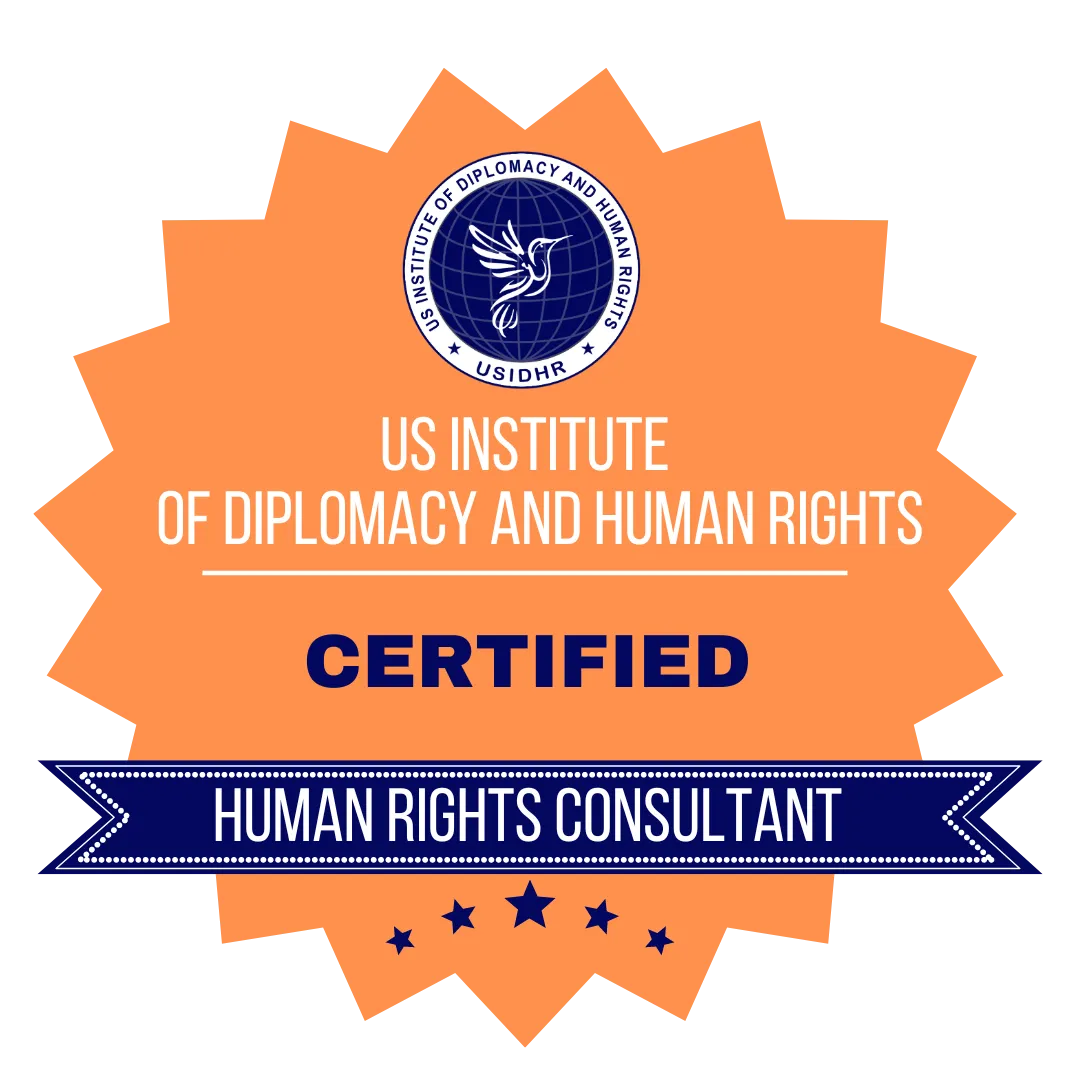
Human Rights Education Certification Training

Human Trafficking Certification
Training

International Business and Diplomatic Protocol Certification

Capacitación En Derechos Humanos

Business Consulting Certification Training

Digital Citizenship Certification
Training

The US Institute of Diplomacy and Human Rights (USIDHR) is an International Continuing Professional Development (CPD) Accredited Organization. Accredited CPD training means the learning activity has reached the required Continuing Professional Development standards and benchmarks. The learning value has been scrutinized to ensure integrity and quality. The CPD Certification Service provides recognized independent CPD accreditation compatible with global CPD requirements

US Institute Of Diplomacy And Human Rights
1250 Connecticut Ave NW Ste 700, Washington, DC 20036


